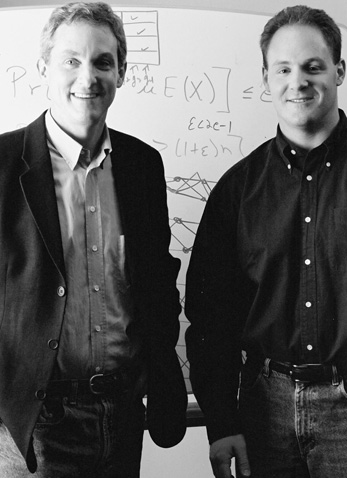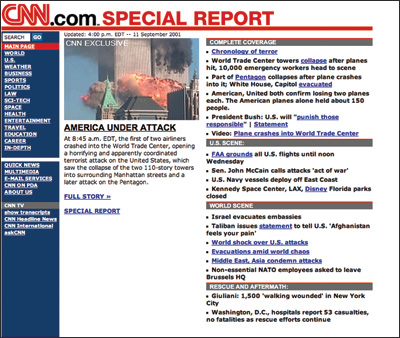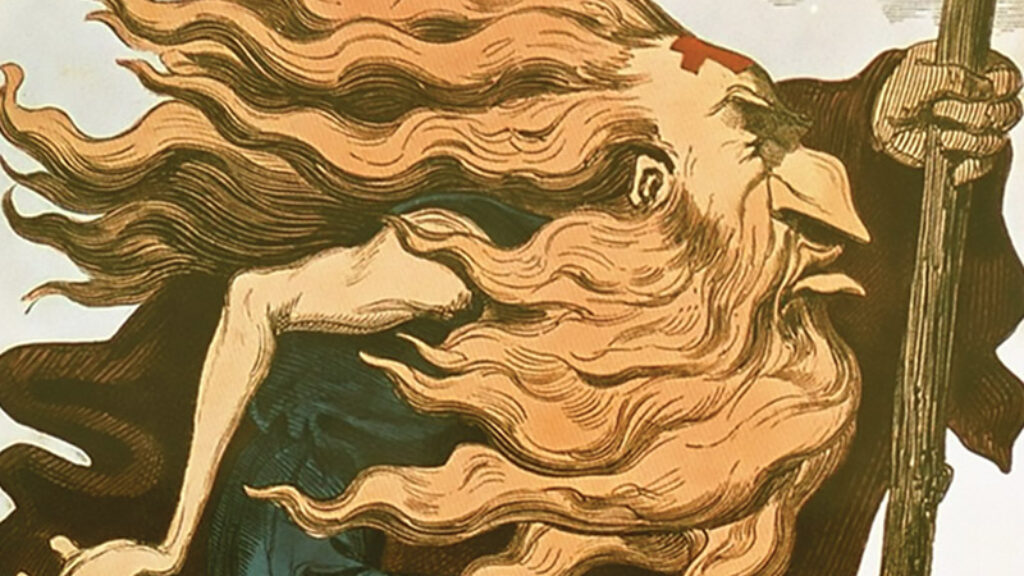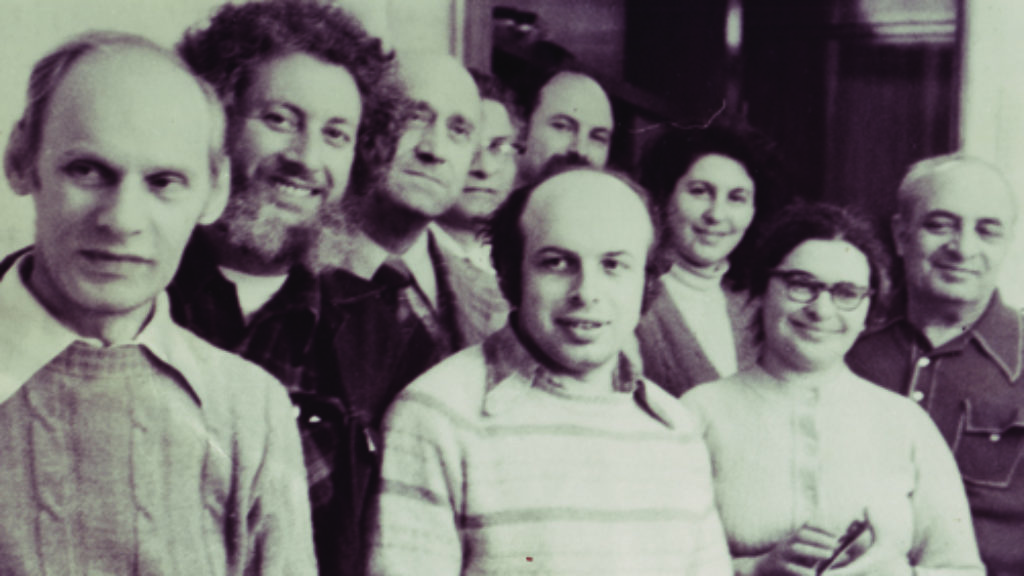Scaling the Internet
Shortly before 9 a.m. on September 11, 2001, employees in the Network Operations Command Center of Cambridge-based Akamai Technologies noticed an unusual increase in Internet traffic. When they learned that it was due to reports of a small plane crashing into the World Trade Center, they were not unduly alarmed. Soon enough, however, it became clear that nothing about the incident was small. After the second plane hit, virtually everyone with an Internet connection was logging on to find out what was happening.
This put an enormous strain on the websites of many of Akamai’s customers, including ABC.com, The Washington Post, and a slew of other news organs, as well as the websites of the Red Cross, the FBI, and American Airlines, which owned both the first plane to strike the towers, Flight 11, and Flight 77, which crashed into the Pentagon. As Molly Knight Raskin puts it in No Better Time, “the spike on 9/11 proved to be the Web equivalent of a 100-year flood.” It was Akamai’s job to help keep the companies that paid for its services afloat. Akamai’s CEO and CFO were both in California and thus unreachable as the telephone networks failed, so Chief Operating Officer Paul Sagan took over. Remembering that day, he said, “There are these times in life, and 9/11 was one of them for me, when all the unimportant things disappear. I went into this zone, which some people may have interpreted as unfeeling, but for me, it was just about how do we get from A to B to C.”

For Sagan, in addition to overseeing engineers working to give greater capacity to websites in the news, aid, and security sectors, getting from A to C included sending an email to the entire company telling them that Danny Lewin, the man whose MIT thesis work had given birth to Akamai and who had been the “heart and soul” of the company since its inception, had died aboard Flight 11. Raskin underscores the tragic irony well:
[I]n 1998, Lewin had called attention to the unpredictable nature of news, foreseeing a time when technology rooted in his algorithms would have the power to keep the Internet alive under an extraordinary crush of traffic. On September 11, 2001, the day of Lewin’s death, the Internet faced its greatest test ever as news of the attacks made its way around the world. Everyone at Akamai faced a stark choice: pause and grieve or press onward. The answer, Sagan said, was clear: “We had to do what Danny would do.”
Akamai’s former customer CNN was struggling to keep its website up that day, after dropping Akamai earlier in the year. No matter what it did, it couldn’t maintain a site under the crush of traffic that was doubling every seven seconds. Around noon, CNN’s teams realized they needed Akamai, and by 1:30 p.m. Akamai’s network was serving the images on CNN.com, on top of delivering content for other major news sites.
Akamai had, indeed, managed to do what Danny Lewin would have done—but who was he? Drawing on interviews with his family, friends, and colleagues, Raskin answers this question with an engaging tale of a continent-straddling and action-packed but all-too-short life. Raskin’s story of one man’s stunning success also elicits a nostalgia for the excitement of those years—when the Internet was new, when one felt real satisfaction when the squawks and beeps of a dial-up modem finally yielded a connection, even if multitasking included clicking back to the browser between other jobs to see if the page one wanted had ever loaded—for the crazy energy of technology’s boom years and for our lost innocence.
Born in a middle-class Denver suburb in 1970, Danny Lewin had it quite good. His professional and intensely intellectual parents raised him and his two younger brothers in a spacious home in a quiet neighborhood. Charles Lewin was the kind of father who pasted math puzzles on the backs of his sons’ cereal boxes, and they were the kinds of boys who enjoyed solving them. In 1979, Charles brought home an Apple II, and Danny, who was just nine years old, taught himself to program it. But he wasn’t a nerd. By eighth grade, he was a popular kid who “skied, flirted with girls, and excelled in both academics and athletics.”
While Danny was having a good time, his father wasn’t. Life in Colorado was just too comfortable, and he increasingly felt the tug of Zion —to which he removed the whole family in 1984, with the children kicking and screaming. Charles, for his part, soon felt “a sense of purposefulness and fulfillment for our lives as Jews.” But Danny, struggling with limited success to master Hebrew and adopt Israeli mannerisms, found himself at a loss. Cutting classes (but more than keeping up with his school assignments), he started training at Samson’s Gym in Jerusalem, where he “worked out until he was blue in the face and his muscles failed, all while sweating and sputtering commands to push himself.” By the time he was 16, he could bench-press more than 300 pounds.
Inspired by the tales he heard from commandos at Samson’s, Lewin entered the Israeli army after high school determined to serve in a “good fighting unit,” and, unusually for a recent immigrant, he made it into the legendary, ultra-elite Sayeret Matkal commando unit. After almost four years of grueling but rewarding service, the newly married Lewin requested leave to attend the Technion in Haifa. It was there that he came across a book on parallel algorithms, written by MIT professor Tom Leighton. Fascinated and inspired, Lewin was eager to meet Leighton. He applied to graduate school at MIT and was accepted.
In 1994, Lewin was back among the elite, one of a handful of students working in Leighton’s theory group, the crème de la crème of MIT’s prestigious Laboratory for Computer Science (LCS). The rest of the students were straight out of college and much younger, not married, as he was, with children. And none of them were able to explain, as he was, the kind of thing “that left everyone wide-eyed, like how much C4 you need to blow up a van (start with a lot, then scale back).” But he was used to being the odd man out.
Tim Berners-Lee, the British computer scientist who invented the World Wide Web and was now running the international group that created governing standards for the Internet, had his offices on the same floor as Leighton’s theory group. Berners-Lee threw them a problem: “come up with a way, mathematically, to scale the Internet,” that is, to solve the growing pains that were turning the World Wide Web into the World Wide Wait.
At first Lewin’s team struggled to find a way to clear Internet bottlenecks, known as “hot spots,” by improving caching technology. Ultimately, Lewin came up with a totally new caching technique: “consistent hashing.” He “set out to develop a new set of algorithms that would claim something no other caching strategy could: fault-tolerance.” Lewin quickly ran into roadblocks, however. His faculty advisor called the idea “insignificant,” and he had doubts himself, once telling a research partner, “Consistent hashing is a pathetic idea, but it’s my idea.” He also said, “he’d will it into greatness if he had to.” And that’s exactly what he did.
First, he got a shot in the arm from Leighton, who thought the idea was a “gem.”
Lewin had taken a succinct problem—one that was easy to state but seemingly impossible to solve—and created a solution so simple and elegant it was almost . . . obvious. “Mathematics has a lot of examples like this, where you could take a thousand people and they wouldn’t be able to solve the problem, but they could all quickly agree when you show them the solution that it’s easy,” Leighton clarified.
Having Leighton on his side helped clear some hurdles, but not all. Lewin’s application to present a paper on consistent hashing at an academic conference was rejected, with committee members saying, “they didn’t think consistent hashing had any hope of being useful.” And despite lining up a stellar team to enter the MIT $50K Entrepreneurship Competition, Lewin and crew (which included Leighton) placed fifth, behind a non-profit Web service that matched would-be volunteers with service organizations and an online wedding gift registry.
But good news followed. Although they hadn’t won the competition, they had learned what investors were looking for, and a pared-down team spent the summer of 1998 turning Danny’s algorithms into a going concern. By Labor Day, they had a working prototype, a better business plan, and support of the business partners they’d need to put that plan into action. Lewin had a tough decision to make. Unlike Leighton and others on the team, he had no fallback plan, no other way of supporting his family if he gave up his stipend from MIT. But Lewin, who had hiked 75 miles in 25 hours to earn his Sayeret Matkal beret, was not one to back down from a challenge. Akamai Technologies (the name comes from a Hawaiian word that means smart or clever) was cofounded in September 1998 by Lewin; Leighton, on sabbatical from MIT; Jonathan Seelig, a student at MIT’s Sloan School of Business; and Randall Kaplan, a business wiz who at age 27 had reported directly to Eli Broad, then-CEO of SunAmerica.
While Akamai’s first investors were family and friends, the team brought in angel investors who could offer not just cash, but valuable contacts. One of them was A&M Records’ Gilbert Friesen, a family friend of Marco Greenberg, Lewin’s closest friend from Israel. Friesen had been with A&M Records from the beginning, making it a haven for top musicians. He didn’t know much about math or computers, but he had an eye for talent. And Lewin, marker in hand at a whiteboard, explaining what Akamai could do, was a talent:
The more he talked and scrawled, the more animated he became, hopping around and grinning from ear to ear as his ideas came to life on its smooth, white surface. As if on cue, he would intermittently turn and look out on his audience, gauging their interest and level of understanding. Friends liken Lewin’s theatrics at the whiteboard to a freight train gathering steam until that stopping point when nearly everyone in the room sat silently wondering what, exactly, had just hit them.
Friesen, who admits he had no idea what Akamai did, says he felt the “familiar sensation” he used to get from watching his biggest stars when they were still unknowns. He walked away having invested half a million dollars.
Akamai’s team worked hard, linking up beta testers that included CNN, Disney, Yahoo, and Warner Brothers. Beta testers turned into paying customers, even as the sales team signed up more big names like the Discovery Channel and Infoseek, which became a paying customer 15 minutes after calling the firm when it needed help keeping its customers ESPN.com and SportsLine USA online during the NCAA “March Madness” basketball tournament.
Despite its many wins, Akamai suffered setbacks, as when venture capital firm Venrock walked away from delivering $4 million in first-round financing the night before the funds were supposed to be wired. The four hundred servers Akamai needed to start rolling out the network were put together with improperly placed screws that came loose in the real-world conditions of a data center. But Lewin imbued his team with an absolute refusal to give up, even if that meant installing a rack of servers using a spare tire repair kit or working punishing hours to deliver services that were sold before they were built.
In the age of irrational exuberance, enthusiasm for Akamai was rational. Tom Leighton had descended from his ivory tower, and Lewin had morphed into a businessman who could dazzle customers who had slammed the door on Akamai’s sales force. Unlike many dot-coms, Akamai had a real product to sell, with real customers writing real checks, no Flooz.com this. And while it had the trappings of dot-com culture—free ice cream, frozen pizza, and soda in the kitchen; programmers taking naps in a hammock; games of miniature golf on a makeshift course between desks—Akamai was different in fundamental ways. Its newly minted millionaires (cofounder Randall Kaplan, who parted ways with the company at the end of 1999, sold his shares for $633 million) for the most part eschewed extravagant purchases, and the company encouraged the students it hired to stay in school, with starting salaries of $70,000 for programmers making student loans extraneous. The company’s leaders shocked the bankers who managed its wildly successful IPO by declining to ring the opening bell at the NASDAQ on the day its stock listed, choosing instead to spend the day working in its Cambridge offices.
But even a company with a sales team that once signed up a hundred new customers in one hundred days didn’t exist in a vacuum. In early 2000, along with the rest of the NASDAQ, Akamai stock took a long plunge—from $307 a share to $7.60—as investors moved back to blue chip stocks. Did it really make sense, they wondered, that AOL, which told people they had mail, had a market capitalization of $222 billion, $100 billion more than the market caps of Ford Motor Company and McDonald’s . . . combined? No matter how smart Akamai’s leaders were or how hard they worked, there was simply no way to insulate the company from either the virtual freefall Internet stock prices were in or the steady loss of revenue as their dot-com customers went under.
On September 10, 2001, Lewin laid out a new vision for Akamai, presenting it to about a dozen employees in an eight-hour meeting. Then he sat down with Leighton for the “grim task of eliminating approximately 500 of the company’s 1,500 employees” in what they both knew would be only the first round of cuts that would be needed to save the company from going under. The next morning he boarded American Airlines Flight 11 from Boston to Los Angeles.

Exactly what Danny Lewin did and what happened to him during the 47 minutes that elapsed between take-off and the collision of the Boeing 767 with the North Tower of the World Trade Center will never be known. But from the reports conveyed by the flight attendants we do know that the passenger in seat 9B—the seat assigned to Danny—was stabbed to death by one of the terrorists. On the basis of this testimony, the 9/11 Commission determined that Satam al-Suqami “most likely killed Lewin by slashing him in the throat from behind as he attempted to stop the hijacking.” Like everyone else who knew him, Marco Greenberg is sure that Danny fought back. “Knowing his character and his training, we know that he got up and tried to do something, and I think he might have taken one of those thugs down with him.” Lewin was, as Greenberg aptly put it, “the first victim of the first war of the twenty-first century.”
In 2002, Akamai was delisted after its stock fell below the $1 threshold and seemed on the verge of becoming yet another dot-com casualty. But Lewin’s elegantly simple algorithms are content-neutral, able to serve up whatever the Internet user requests—even as businesses went back to basics and CNN’s home page filled with celebrity and lifestyle “news.” The company Lewin built has held on, returning to profitability in 2004 and growing to 3,500 employees and a market cap, as of this writing, of $9.3 billion. Today it is a leader not only in content delivery but also in cyber-security.
After Danny Lewin’s remains were identified in the wreckage of the World Trade Center, he was buried in Sharon Memorial Park outside of Boston, but his friends and relatives have honored his memory both in this country and in Israel. Marco Greenberg has, among other things, established “an annual writing award—on the topic of technology and cyber-terrorism—in Danny’s name at the U.S. Army War College.” Tom Leighton visited Israel in 2012, around the time that Akamai purchased the large Israeli company Cotendo, finally realizing “Lewin’s dream of a presence in Israel.” After Leighton delivered a lecture in Danny’s memory at the Computer Engineering Center of the Technion, Danny’s alma mater, one of the students asked how Akamai had managed to succeed in such tumultuous times. “Leighton barely hesitated: ‘One word, really,’ he said. ‘Danny.’’’
Suggested Reading
Swept Up
A new documentary displays the process of conversion to Judaism.

Wandering Jews
Jews have been travelers since God told Abraham to get up and go. How deeply has this constant motion been imprinted on the Jewish psyche?

Let My People Go
Many of the heroes of the Soviet Jewry movement have been unsung, until now.
Heart Work
As a successful young novelist, my father had literary friends who now included Angus Wilson, Frederic Raphael, John Wain, and Isaac Bashevis Singer. All came to tea in my nursery. Stanley Moss, my godfather, went on to make a fortune from art dealing.
Comments
You must log in to comment Log In